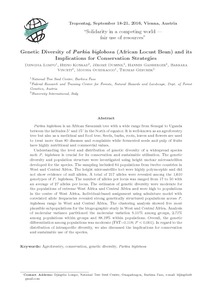Resource information
Parkia biglobosa is an African Savannah tree with a wide range from Senegal to Uganda between the latitudes 5 and 15° in the North of equator. It is well-known as an agroforestry tree but also as a medicinal and food tree. Seeds, barks, roots, leaves and flowers are used to treat more than 80 diseases and complaints while fermented seeds and pulp of fruits have highly nutritional and commercial values.
Understanding the level and distribution of genetic diversity of a widespread species such P. biglobosa is crucial for its conservation and sustainable utilisation. The genetic diversity and population structure were investigated using height nuclear microsatellites developed for the species. The sampling included 84 populations from twelve countries in West and Central Africa. The height microsatellite loci were highly polymorphic and did not show evidence of null alleles. A total of 217 alleles were revealed among the 1,610 genotypes of P. biglobosa. The number of alleles per locus was ranged from 17 to 50 with an average of 27 alleles per locus. The estimates of genetic diversity were moderate for the populations of extreme West Africa and Central Africa and were high to populations in the centre of West Africa. Individual-based assignment using admixture model with correlated allele frequencies revealed strong genetically structured populations across P. biglobosa range in West and Central Africa. The clustering analysis showed five most plausible subpopulations for the biogeographic study in West and Central Africa. Analysis of molecular variance partitioned the molecular variation 9.10% among groups, 2.71% among populations within groups and 88.19% within populations. Overall, the genetic differentiation among populations was moderate (FST=0.118; P<0.001). In regard to the distribution of intraspecific diversity, we also discussed the implications for conservation and sustainable use of the species.


